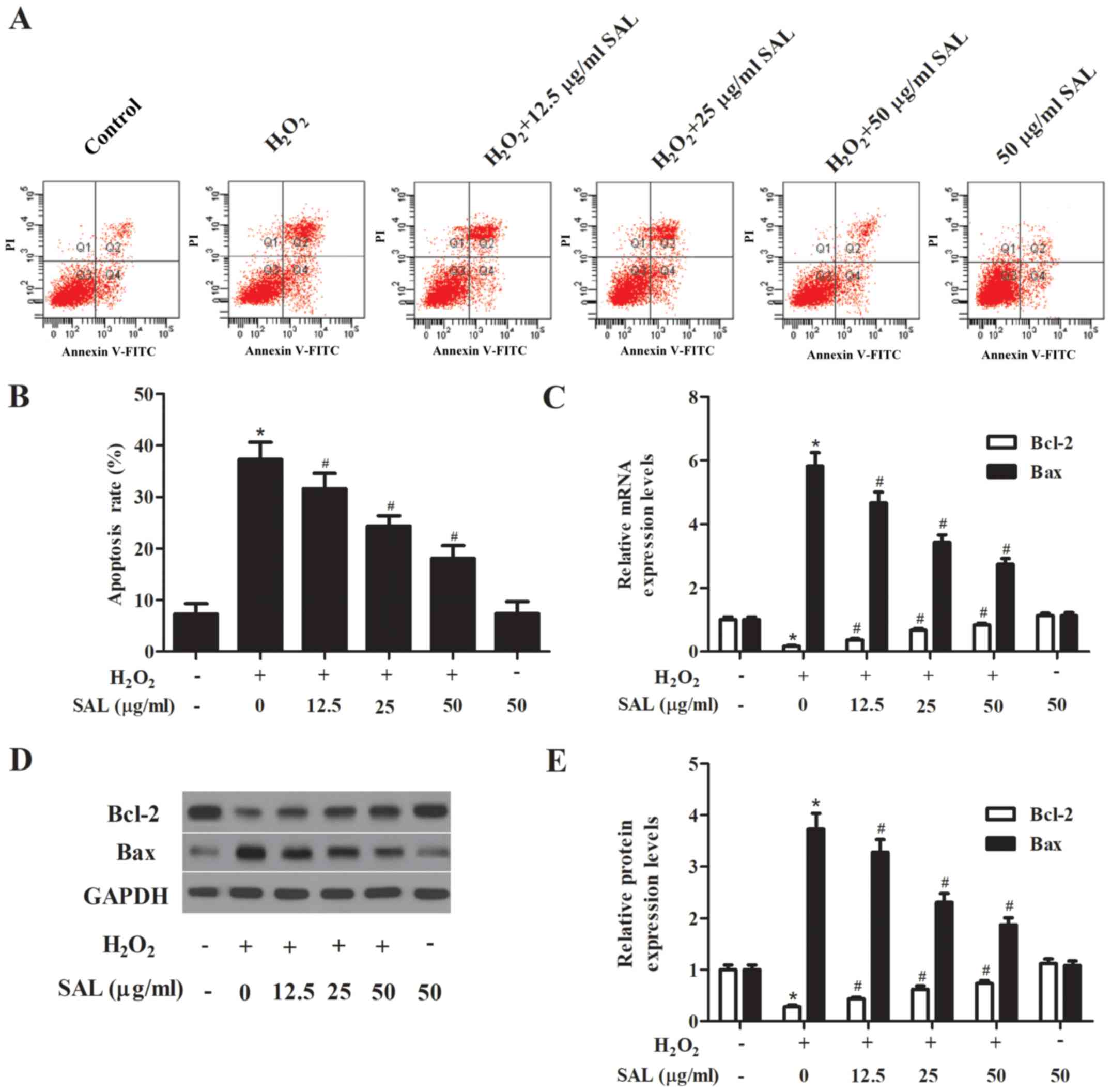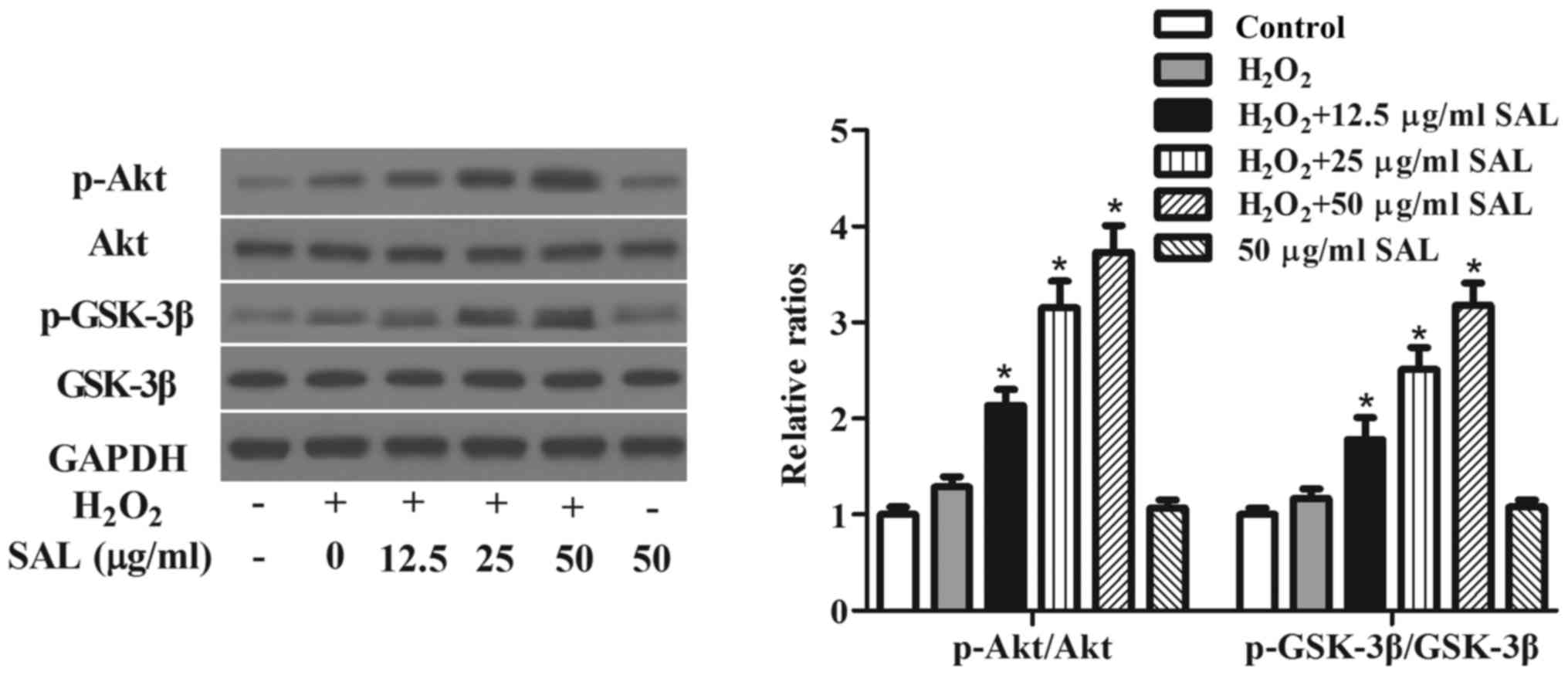|
1
|
Friedman DS, O'Colmain BJ, Muñoz B, Tomany
SC, Mccarty C, de Jong PT, Nemesure B, Nemesure B, Mitchell P and
Kempen J; Eye Diseases Prevalence Research Group, : Prevalence of
age-related macular degeneration in the United States. Arch
Ophthalmol. 122:564–572. 2004. View Article : Google Scholar : PubMed/NCBI
|
|
2
|
Strauss O: The retinal pigment epithelium
in visual function. Physiol Rev. 85:845–881. 2005. View Article : Google Scholar : PubMed/NCBI
|
|
3
|
Dong A, Xie B, Shen J, Yoshida T, Yokoi K,
Hackett SF and Campochiaro PA: Oxidative stress promotes ocular
neovascularization. J Cell Physiol. 219:544–552. 2009. View Article : Google Scholar : PubMed/NCBI
|
|
4
|
Lu L, Hackett SF, Mincey A, Lai H and
Campochiaro PA: Effects of different types of oxidative stress in
RPE cells. J Cell Physiol. 206:119–125. 2006. View Article : Google Scholar : PubMed/NCBI
|
|
5
|
Glotin AL, Calipel A, Brossas JY, Faussat
AM, Tréton J and Mascarelli F: Sustained versus transient ERK1/2
signaling underlies the anti- and proapoptotic effects of oxidative
stress in human RPE cells. Invest Ophthalmol Vis Sci. 47:4614–4623.
2006. View Article : Google Scholar : PubMed/NCBI
|
|
6
|
Beatty S, Koh H, Phil M, Henson D and
Boulton M: The role of oxidative stress in the pathogenesis of
age-related macular degeneration. Surv Ophthalmol. 45:115–134.
2000. View Article : Google Scholar : PubMed/NCBI
|
|
7
|
Sun L, Isaak CK, Zhou Y, Petkau JC, O K,
Liu Y and Siow YL: Salidroside and tyrosol from Rhodiola protect
H9c2 cells from ischemia/reperfusion-induced apoptosis. Life Sci.
91:151–158. 2012. View Article : Google Scholar : PubMed/NCBI
|
|
8
|
Li D, Fu Y, Zhang W, Su G, Liu B, Guo M,
Li F, Liang D, Liu Z, Zhang X, et al: Salidroside attenuates
inflammatory responses by suppressing nuclear factor-κB and mitogen
activated protein kinases activation in lipopolysaccharide-induced
mastitis in mice. Inflamm Res. 62:9–15. 2013. View Article : Google Scholar : PubMed/NCBI
|
|
9
|
Mao GX, Wang Y, Qiu Q, Deng HB, Yuan LG,
Li RG, Song DQ, Li YY, Li DD and Wang Z: Salidroside protects human
fibroblast cells from premature senescence induced by H(2)O(2)
partly through modulating oxidative status. Mech Ageing Dev.
131:723–731. 2010. View Article : Google Scholar : PubMed/NCBI
|
|
10
|
Hu X, Zhang X, Qiu S, Yu D and Lin S:
Salidroside induces cell-cycle arrest and apoptosis in human breast
cancer cells. Biochem Bioph Res Commun. 398:62–67. 2010. View Article : Google Scholar
|
|
11
|
Shi TY, Feng SF, Xing JH, Wu YM, Li XQ,
Zhang N, Tian Z, Liu SB and Zhao MG: Neuroprotective effects of
Salidroside and its analogue tyrosol galactoside against focal
cerebral ischemia in vivo and H2O2-induced neurotoxicity in vitro.
Neurotox Res. 21:358–367. 2012. View Article : Google Scholar : PubMed/NCBI
|
|
12
|
Zhang L, Yu H, Zhao X, Lin X, Tan C, Cao G
and Wang Z: Neuroprotective effects of salidroside against
beta-amyloid-induced oxidative stress in SH-SY5Y human
neuroblastoma cells. Neurochem Int. 57:547–555. 2010. View Article : Google Scholar : PubMed/NCBI
|
|
13
|
Baek SM, Yu SY, Son Y and Hong HS:
Substance P promotes the recovery of oxidative stress-damaged
retinal pigmented epithelial cells by modulating Akt/GSK-3β
signaling. Mol Vis. 22:1015–1023. 2016.PubMed/NCBI
|
|
14
|
Cao X, Liu M, Tuo J, Shen D and Chan CC:
The effects of quercetin in cultured human RPE cells under
oxidative stress and in Ccl2/Cx3cr1 double deficient mice. Exp Eye
Res. 91:15–25. 2010. View Article : Google Scholar : PubMed/NCBI
|
|
15
|
Cia D, Vergnaud-Gauduchon J, Jacquemot N
and Doly M: Epigallocatechin gallate (EGCG) prevents H2O2-induced
oxidative stress in primary rat retinal pigment epithelial cells.
Curr Eye Res. 39:944–952. 2014. View Article : Google Scholar : PubMed/NCBI
|
|
16
|
Koskela A, Reinisalo M, Hyttinen JM,
Kaarniranta K and Karjalainen RO: Pinosylvin-mediated protection
against oxidative stress in human retinal pigment epithelial cells.
Mol Vis. 20:760–769. 2014.PubMed/NCBI
|
|
17
|
Liang FQ and Godley BF: Oxidative
stress-induced mitochondrial DNA damage in human retinal pigment
epithelial cells: A possible mechanism for RPE aging and
age-related macular degeneration. Exp Eye Res. 76:397–403. 2003.
View Article : Google Scholar : PubMed/NCBI
|
|
18
|
Beatty S, Koh H, Phil M, Henson D and
Boulton M: The role of oxidative stress in the pathogenesis of
age-related macular degeneration. Surv Ophthalmol. 45:115–134.
2000. View Article : Google Scholar : PubMed/NCBI
|
|
19
|
Klein R, Myers CE, Cruickshanks KJ,
Gangnon RE, Danforth LG, Sivakumaran TA, Iyengar SK, Tsai MY and
Klein BE: Markers of inflammation, oxidative stress, and
endothelial dysfunction and the 20-year cumulative incidence of
early age-related macular degeneration: The beaver dam eye study.
JAMA Ophthalmol. 132:446–455. 2014. View Article : Google Scholar : PubMed/NCBI
|
|
20
|
Xu MC, Shi HM, Wang H and Gao XF:
Salidroside protects against hydrogen peroxide-induced injury in
HUVECs via the regulation of REDD1 and mTOR activation. Mol Med
Rep. 8:147–153. 2013. View Article : Google Scholar : PubMed/NCBI
|
|
21
|
Zhu Y, Shi YP, Wu D, Ji YJ, Wang X, Chen
HL, Wu SS, Huang DJ and Jiang W: Salidroside protects against
hydrogen peroxide-induced injury in cardiac H9c2 cells via PI3K-Akt
dependent pathway. Dna Cell Biol. 30:809–819. 2011. View Article : Google Scholar : PubMed/NCBI
|
|
22
|
Fujihara M, Nagai N, Sussan TE, Biswal S
and Handa JT: Chronic cigarette smoke causes oxidative damage and
apoptosis to retinal pigmented epithelial cells in mice. PLoS One.
3:e31192008. View Article : Google Scholar : PubMed/NCBI
|
|
23
|
Mao H, Seo SJ, Biswal MR, Li H, Conners M,
Nandyala A, Jones K, Le YZ and Lewin AS: Mitochondrial oxidative
stress in the retinal pigment epithelium leads to localized retinal
degeneration. Invest Ophthalmol Vis Sci. 55:4613–4627. 2014.
View Article : Google Scholar : PubMed/NCBI
|
|
24
|
Shi K, Wang X, Zhu J, Cao G, Zhang K and
Su Z: Salidroside protects retinal endothelial cells against
hydrogen peroxide-induced injury via modulating oxidative status
and apoptosis. Biosci Biotechnol Biochem. 79:1406–1413. 2015.
View Article : Google Scholar : PubMed/NCBI
|
|
25
|
Qiao Z, Xu YW and Yang J: Eupatilin
inhibits the apoptosis in H9c2 cardiomyocytes via the Akt/GSK-3β
pathway following hypoxia/reoxygenation injury. Biomed
Pharmacother. 82:373–378. 2016. View Article : Google Scholar : PubMed/NCBI
|
|
26
|
Lv D, Bai Z, Yang L, Li X and Chen X:
Lipid emulsion reverses bupivacaine-induced apoptosis of h9c2
cardiomyocytes: PI3K/Akt/GSK-3β signaling pathway. Environ Toxicol
Pharmacol. 42:85–91. 2016. View Article : Google Scholar : PubMed/NCBI
|
|
27
|
Ramírez-Sánchez J, Simões Pires EN,
Nuñez-Figueredo Y, Pardo-Andreu GL, Fonseca-Fonseca LA, Ruiz-Reyes
A, Ochoa-Rodríguez E, Verdecia-Reyes Y, Delgado-Hernández R, Souza
DO and Salbego C: Neuroprotection by JM-20 against oxygen-glucose
deprivation in rat hippocampal slices: Involvement of the
Akt/GSK-3β pathway. Neurochem Int. 90:215–223. 2015. View Article : Google Scholar : PubMed/NCBI
|
|
28
|
Yang P, Peairs JJ, Tano R and Jaffe GJ:
Oxidant-mediated Akt activation in human RPE cells. Invest
Ophthalmol Vis Sci. 47:4598–4606. 2006. View Article : Google Scholar : PubMed/NCBI
|
|
29
|
Yan T, Bi H and Wang Y: Wogonin modulates
hydroperoxide-induced apoptosis via PI3K/Akt pathway in retinal
pigment epithelium cells. Diagn Pathol. 9:1542014. View Article : Google Scholar : PubMed/NCBI
|
|
30
|
Wang K, Jiang Y, Wang W, Ma J and Chen M:
Escin activates AKT-Nrf2 signaling to protect retinal pigment
epithelium cells from oxidative stress. Biochem Bioph Res Commun.
468:541–547. 2015. View Article : Google Scholar
|













